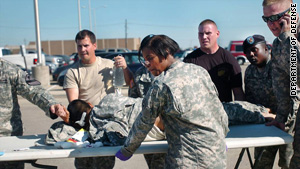Fort Hood first responders remained calm amid chaos

- First responders credited with stopping Maj. Nidal Hasan, saving his life
- Officer praised for disabling Hasan shot in legs, wrist
- Witness: "Every soldier was helping everybody out, every civilian that worked there"
- Thirteen people died, 38 others wounded in shooting
A CNN Special Investigation drills down on the causes and the impact of the Fort Hood shootings, at 8 p.m. ET Saturday on CNN TV.
FORT HOOD, Texas (CNN) -- The first people who came across Maj. Nidal Malik Hasan, the psychiatrist suspected of Thursday's murderous rampage, told tales Friday of quick, calm efforts in the face of danger.
By the time it was over -- in less than five minutes, base commander Lt. Gen. Bob Cone said -- 13 people were dead and 38, including Hasan, were wounded.
Mark Todd was one of two civilian police sergeants credited with helping take down Hasan. He and partner Kimberly Munley pulled up outside the building where the shooting was occurring at the same time, and Todd saw the shooter standing outside -- about 15 yards away. He appeared calm.
"As soon as we got there, it was game on, and then that's when it escalated, and we did what we had to do," he told CNN's "Anderson Cooper."
"I yelled at him, 'Stop! Drop the weapon!' And that's when he raised his weapon and fired a couple of shots at me."
Todd said he and Munley both took cover and as Hasan walked around one side of the building, he went around the other. "That's when I saw him again. I told him to drop his weapon and he fired a couple more rounds. He fell, I went up and secured his weapon."
As soon as his weapon had been taken away, medics appeared, Todd said.
"It was like instantaneous," he said. "We started life-saving measures to keep him alive as well."
Specialist Francisco de la Serna, a medic, was among those who treated the wounded, including Munley, shot in both thighs and a wrist, and the suspect.
"When the first gunshots started, you know, it was complete chaos," he told CNN's "Larry King Live." "Just everyone outside the building started scattering. They just all ran behind anything that would stop a bullet -- cars, trash cans, trees, anything."
De la Serna said he came upon Munley, who was already being helped by others. "I made a tourniquet, put it around her thigh and put it down until the bleeding stopped, but she'd already lost a lot of blood," he said. "She was fading in and out of consciousness."
He then turned his attention to Hasan, asking him where he had been shot.
"I couldn't get him to answer," de la Serna said. "He looked really calm, really pale."
 Video: Medic treated cop and suspect
Video: Medic treated cop and suspect  Video: Eyewitness speaks out
Video: Eyewitness speaks out  Video: Profile of Ft. Hood hero
Video: Profile of Ft. Hood hero Army reservist Sgt. Jeannette Juroff also stepped in to help the wounded, but first she and some co-workers took refuge in a bathroom.
Juroff told CNN's "Campbell Brown" that she was taking her lunch break when she overheard fellow soldiers saying they heard shooting. At first, that didn't alarm her.
"This is Fort Hood, shooting goes on," she said.
But when a major told her to call 911, she tried to do so, but couldn't get through, she said. Soon, it became apparent that the threat was real.
"I was walking down the hall and wondering what I would tell 911 and then a lot of my coworkers come in and they said, 'Just get in the bathroom.'"
They took refuge there for about a minute, "but it felt like it took forever," she said. "It was so quiet, but then we heard just loud screams and stomps, a lot of chaos going on."
Unwilling to stay cooped up in the tiny room as an unknown danger lurked outside, they opened the door and ran out, she said. Ahead of them she saw the building exit and the conference center where the shooting was taking place.
Then, her cell phone rang -- it was one of her captains calling to talk about administrative matters.
"I just said, 'Shut up, I need to talk to you. Call 911.' He called 911," she said.
By now, she had figured out what to say. "I said, 'We're coming under attack. There's somebody shooting at the SRP," she said, using soldier shorthand for "soldier readiness program."
"As I'm talking to him, I'm seeing a soldier who's wounded and there's two soldiers holding his leg up, a medic and others helping," she said.
The soldier they were working on appeared in shock, his lips a pasty white, so Barbour said she tried to calm him down. "I just went in there and said, 'Hey kid, whatcha doing?'" she recalled. The two talked about pool, about their weekend plans "and, little by little, he started to look good."
Authorities said Friday that the 18-year-old wounded soldier was going to recover.
All around them, medics were working at high speed, she said. "They were just completely doing everything they were told to do, every soldier was helping everybody out, every civilian that worked there."
In one area, a "nearly naked" soldier -- his pants torn -- was using his hands to put pressure over a wound to keep the blood from pouring out, she said.
"He was staying calm and everybody else was doing the same," she said. "It was really awesome."



